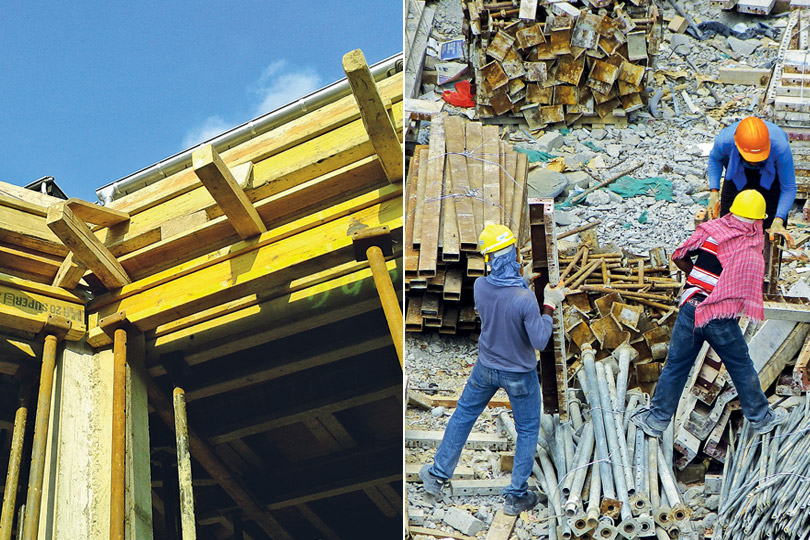In recent years, the Singapore government has been championing the adoption of new technologies in the building and construction sector to increase productivity and reduce reliance on foreign manpower.

The reward at the end of the day is worthwhile: the transformation of Singapore’s construction sector into one that is cleaner and faster, but with no trade-off in quality and safety.
While efforts are gathering pace, there is both room for improvement and need for urgency, with construction labour productivity falling 1.3 per cent in the first half of 2014 compared to the same period a year ago.
Building Information Modelling (BIM)
The range of new technologies the government is introducing span the different stages of a project lifecycle. One such technology that can impact productivity during the design and planning stage is Building Information Modelling (BIM).
BIM is a new three-dimensional modeling technology, which allows a building project to be explored and reviewed digitally, even before a single brick has been laid. The Building and Construction Authority (BCA) has identified BIM as game-changing technology, with the ability to engender greater integration and collaboration between building professionals working across the construction value chain.
BCA is encouraging the adoption of BIM by the local building and construction sector, and has mandated in electronic submissions BIM format for regulatory approval of architectural, structural and mechanical and electrical (M&E) building work plans by 2015, starting with architectural e-submissions in 2013.
Early adopters here have already reported positive feedback, with companies surveyed reporting an average of 30 per cent improvement in efficiency due to better visualisation, upfront conflict resolution, reduced errors and consistent documentation.
Prefabricated Prefinished Volumetric Construction (PPVC) & Cross-Laminated Timber (CLT)
Beyond design and planning, the government is also driving adoption of new technologies during the construction phase of the project life cycle.
During the 2014 Budget debate, the Ministry of National Development (MND) announced that developers would have to adopt productive technologies for selected Government Land Sale (GLS) sites from the second half of the year.
These technologies include PPVC for hotels and residential projects and CLT for low and medium-rise buildings. Prefabricated bathroom units (PBUs) will be mandated for residential GLS sites, while industrial GLS sites will also require a minimum level of prefabrication.
For PPVC, complete flats or modules made of multiple units are manufactured in factories, before being transported on site for installation and piecing together. PPVC can help speed up the construction process, potentially achieving a productivity improvement of 30 to 50 per cent for manpower and time savings respectively.
In an August blog post, Minister for National Development Khaw Boon Wan announced that a 10-storey building extension to the Crown Plaza Changi Airport Hotel would be constructed using the PPVC method.
Meanwhile, in the USA, the upcoming Atlantic Yards development in Brooklyn will boast the world’s largest tower built using the PPVC method. At 32 storeys when complete, the residential tower dubbed B2 will only take 20 months to build compared to 30 months using conventional construction methods.
CLT is an advanced material manufactured from wood harvested from sustainably managed forests and fabricated by binding layers of timber at 90 degrees with structural adhesives to produce a solid timber panel. First developed in Switzerland in the 1990's, CLT has become popular in Europe, with Austria alone accounting for 80 per cent of the world's CLT supply.
CLT is significantly lighter than steel and concrete, thus making it much easier to handle. This also brings about a quieter construction and cleaner construction sites, since modules are prefabricated in factories and assembled on site. Usage of CLT can also positively impact productivity and reduce the overall duration of construction by 30 to 35 per cent with fewer workers required.
The Forte in Melbourne, Australia, at 10 storeys is currently the tallest residential timber building in the world. In Singapore, the Nanyang Technological University (NTU) has also committed to constructing its new sports hall using CLT.
Other Measures
Besides mandating the usage of such productive technologies on GLS sites, the BCA will also be incentivising industry players by providing funding support for adopters of such technologies.
The government agency will also create the requisite eco-system for these technologies to flourish by working with SPRING Singapore and industry players to develop standards, codes and guidelines. In terms of education, the BCA Academy is rolling out courses, workshops and seminars on the new technologies to build up expertise in the sector.
Meanwhile, the government has also pledged to set the right example by deploying such technologies in select public sector projects.
Level Up
Having recognised the pressing need to bring Singapore's building and construction sector to a higher level of productivity, the government has mapped out a comprehensive roadmap to achieve just that.
From identifying the relevant technologies to providing funding and incentives for their adoption, as well as mandating their use for developments on GLS sites, the right set of conditions are in place for these technologies to take root and flourish here.